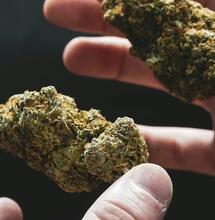FDA Reflects on 50 Years of Marijuana Research

New FDA documents take a journey back into five decades of marijuana research while also contemplating future studies on cannabis products, cannabinoids and terpenes. The Food and Drug Administration has been evaluating applications from drug-makers and researchers for new cannabis-derived drugs for as long as the federal government has classified marijuana a Schedule I controlled substance.
The FDA came forward with a pair of new documents where it looks back on its history of investigational activities around cannabis-based drugs. At the same time, the papers offer the agency’s perspectives of future cannabis drug development. In the FDA’s view, the focus in the next years tilts towards the different delivery methods such as edibles and research on cannabis components we’re less familiar with, such as terpenoids.
Agency representatives said that over the past half of a century, the FDA has evaluated over 800 investigational new drug applications (INDs) that relate to cannabis and cannabis-derived products (CCPDs). The period has been marked by tectonic changes, including the rise of the cannabis industry, evolving cultural views around cannabis use and legalization of the plant, all of which has impacted the work of the agency.
Dramatic Changes for Cannabis Research in the Last Decade
In the very start of receiving applications, or with the passage of the federal Controlled Substances Act (CSA) in 1971, the agency oversaw only a few cannabis-related submissions. In the last couple of years however, thanks to the ever-advancing legalization of the plant, the agency has seen a huge spike in applications from drug-developers.
Around 400 applications have been submitted to the FDA in the last ten years alone, or roughly the same number of cannabis-related drug applications as the previous 40 years together. At the moment, some 150 applicants are awaiting their evaluation outcome.
“The current data shows that applications for research of these products submitted by both academic researchers and commercial developers focus on four major clinical areas: addiction and pain medicine (53%), neurology (19%), immunology and inflammation (14%), and psychiatry (9%),” the agency says in an article in the journal Exploration of Medicine.
In the past, INDs were usually around smokable forms of marijuana, FDA said. But the variety of cannabis forms has “dramatically expanded” after 2010 and all sorts of products have entered clinical research, including oils, tinctures, and infused edible items such as baked goods and sweets.
“The increase in the type of products and ROAs [routes of administration] being studied in clinical trials correlates with the drug approvals of Syndros (2016) and Epidiolex (2018), which are both oral formulations,” the article notes.
The paper recognizes that the new generation of cannabis consumers has “transitioned from exclusively smoking dried cannabis flower to consuming other non-flower forms, such as edibles.”
“Overall, edibles have grown significantly as a product type. This growth could be attributed to the use and access to edible products, as well as a general reduced stigma around cannabis use in current society,” it says.
The agency officials further note that bringing these products for clinical testing comes with a unique set of challenges, which can include inadequate quality and manufacturing information, unknown safety profiles, and unknown benefits/risks for emerging compounds such as HHC or THC-O.
The agency officials also took the opportunity to address future cannabis drug-makers and researchers that they “should consult DEA about the applicable requirements.”
“It may be useful for researchers to calculate the delta-9 THC content in their proposed CCDP early in the development process to gain insights into the product’s potential abuse liability and control status,” reads one of the tips given.
DEA does have a guidance document on botanical drug development in place since 2016. Early this year, the agency also released a separate guidance document that outlines the unique considerations around cannabis and cannabinoid-derived compounds.
“The FDA will continue to encourage robust clinical research of CCDPs,” it stands in the article’s concluding paragraphs. “The Agency supports sound, scientifically based research into the therapeutic uses of CCDPs and will continue to work with companies interested in bringing safe, effective, and quality drug products to market,” it says.
Also read on Soft Secrets:
- FDA and FTS Warn About 'Imitation' Delta-8 Edibles












